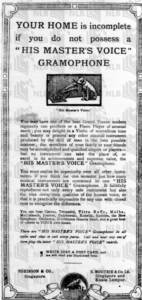In his book Cities in Motion: Urban Life and Cosmopolitanism in Southeast Asia, Su Lin Lewis articulates the role of soundscapes and cinema in globalising Asian cities. One interesting aspect explored is the impact of the gramophone in injecting new life into leisure entertainment.1 Lewis articulates that around the ‘gramophone and wireless created a new, mass experience of listening to music and stories, divorced from live experience and occurring in the comfort of one’s home, or in the home of one’s neighbour, or in a crowd on a street.’2 Essentially, the gramophone, emerging as a cultural conduit in ones home, severed the tether to live experiences, granting a global audience unprecedented access to diverse cultural expressions.
This discussion seeks to explore the role of the gramophone as a social space in globalising Asian cities.
Lewis notes that this phenomenon was not a simple diffusion from West to East but a complex interplay involving local and regional influences. Lewis places significant emphasis on the gramophone market in Burma. Narrated through a story in Ranghoon’s University College Annual, Lewis traces the clash of musical preferences between an ‘old-fashioned Burman’ and the younger generation, symbolising the generational divided.3 The influx of Burmese renditions of English songs, accompanied by instruments like Hawaiian guitars and Hilly Billy Banjos, created a sensory transformation. While concerns were raised about the potential influence of swing and hot-cha music, the adaption of jazz tunes by Burmese musicians interestingly led to the preservation of diverse musical traditions in Burma and exposed local audiences to both Western and Asian music. Lewis highlights the pivotal role played by the gramophone – divorcing music from live performances and bringing a mass experience of global sounds to Burmese homes, streets and communities.
Lewis proposes that the cultural adaption observed in Burma was not an isolated occurrence but rather part of a worldwide phenomenon.4 Therefore, this discussion will expand this exploration to Singapore during the early 20th century, with a particular focus on the role played by His Master’s Voice (HMV) Gramophone Company. As a global player, HMV, initially founded in London, established a noteworthy presence in Singapore, contributing to the cultural exchange facilitated by the technological advancements of the gramophone.
The gramophone’s ability to mechanically reproduce music facilitated a cultural exchange, exposing a multi-cultural city to various musical styles.
Similar, to the situation in Burma, HMV’s recordings in Singapore exposed local audiences to various forms of music, fostering a sense of cosmopolitanism and modernity. The adaptability of simple jazz tunes and the incorporation of diverse musical traditions became part of the sensory transformation of Singapore into a modern Asian city. The recordings not only preserved existing musical traditions but also played a role in the creation of new and modern popular genres.5
Figure 1, an advertisement of an HMV gramophone found in the Straits Chronicle 1915, provides valuable insights into the cultural impact of the gramophone. The title ‘your home is incomplete if your home does not possess a “His Master’s Voice Gramophone,”‘ conveys that the gramophone is more than a mere functional device; it is a status symbol and a valuable addition to one’s identity. Indeed, the gramophone came to be one of the prime symbols of class formation, modernity and social change. It was especially favoured by a small, yet distinct community known as the Peranakan Chinese in Singapore, for its capacity to acquire ‘culture’ and bring both global and local music to the home.6 It goes on the articulate that ‘you must realise its superiority over all other instruments, if you think for one moment just how many musical instruments are contained in one.’ This propagandist assertion underscores the gramophone’s technological advancements, showcasing an ability to reproduce diverse sounds, distinguishing between various local cultural and foreign instruments and styles with clarity. Indeed, gramophone recordings by the HMV in Singapore were a fusion of stylistic borrowing and localisation. Musicians adapted to changes in British colonial society, actively merging elements of commercial Anglo-American popular music wit Malay lyrics about the problems and hopes of ordinary people to generate new meanings.7

Figure 1. ‘Advertisements Column 3,’ Pinang Gazette and Straits Chronicle, 4th March 1915.8
Furthermore, the invitation to ‘hear Caruso, Tetrazzini, Titta Ruffo, Melba, McCormack, Journet, Paderewski, Kubelik, Kreisler, the New Symphony Orchestra, Coldstream Guards Band, and a great host of hosts of others in YOUR house,’ emphasises how the gramophone acted as cultural bridge, bringing so many voices to the homes of ordinary people. This further highlights a new consumer culture in Singapore where variety was clearly appreciated.
Clearly, western technology and the colonial market system provided a hybrid, cosmopolitan and inclusive modernity that aimed to create a more modern society. This underscores and helps advance Lewis’s argument that the gramophone helped to globalise Asian cities.
- Su Lin Lewis, Cities in Motion: Urban Life and Cosmopolitanism in Southeast Asia, 1920-1940, (2016), p. 238 [↩]
- Lewis, Cities in Motion, p. 228 [↩]
- Ibid., p. 231. [↩]
- Ibid., p. 232 [↩]
- Tan Sooi Beng, ‘Negotiating “His master’s Voice”: Gramophone Music and Cosmopolitan Modernity in British Malaya in the 1930s and Early 1940s, Bijdragen tot de Taal-, Land- en Volkenkunde, 169:4 (2013), p. 461 [↩]
- Peter Lee and Jennifer Chen, Rumah Baba: Life in a Peranakan House, (Singapore, 1998), p.93 [↩]
- Beng, ‘Negotiating “His master’s Voice,”’ p. 459 [↩]
- Figure 1. ‘Advertisements Column 3,’ Pinang Gazette and Straits Chronicle, 4th March 1915, p. 2 [↩]